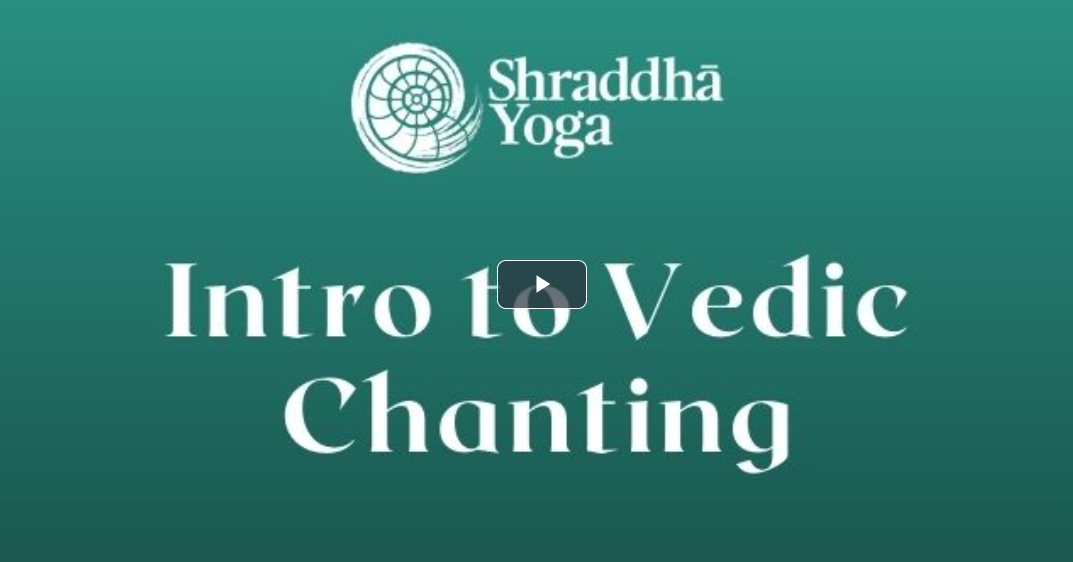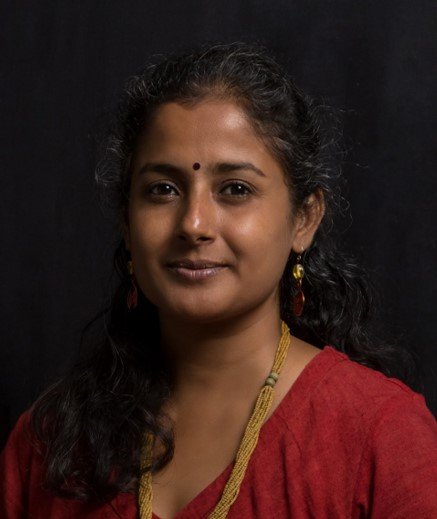<< All WorkshopsVedic Chanting - 3 levels
What is Vedic Chanting?
Interested in this course but want to learn more? Watch the free introductory talk where Sangeetha gives an overview of the following:
Basic introduction to the Krishnamacharya Tradition - philosophy of Yoga, and the location of chanting (shlokas and mantras) in one's sadhana.
What is vedic chanting and how is it similar to and different from other forms of chanting?
What are the benefits of chanting veda mantras?
What are the requirements to register for the course?
What one can expect from the course, and what will be expectations of the students registering for the course?
Designed to deepen your engagement and experience of Yoga through chanting.
Understand and experience Vedic chanting, integrate it into your personal practice, and learn to chant simple Vedic mantras following the six rules of chanting, plus the meaning and significance of each mantra.
Want an example of Vedic Chanting? Listen to Sangeetha chant Shraddha Suktam:
What People Are Saying
“Stepping into the path of Vedic Chanting is something I have considered for over a decade... Sangeetha is a wonderful teacher, very knowledgeable, very clear, very warm and caring. Each lesson is rich and full, but not too much to be overwhelming. I feel a change in consciousness when I practice. I feel like my brain and my body are being rewired as I do my weekly lessons. And of course, the energy that comes through our weekly classes is so sweet for my soul. I pray I am able to learn and practice with Sangeetha for a long time. This journey is a tender one.”
— Elyssa Marie Serrilli
“I have found this course to be very beneficial in focusing my mental attention. After listening to the chants and practicing them a few times I feel more relaxed and focused and better able to tackle the challenges of my day in a centered way.
— Amber O'Brien
About Vedic Chanting and the tradition
Veda mantras are classified as śruti and can be imagined as cosmic vibrational patterns that were revealed to rishis (seers) in their deeply meditative states, in the form of sound. These mantras need to be learnt and chanted following specific rules of chanting, exactly the way they were originally received and passed on. And for this reason, it is important to learn Vedic chanting from teachers who come from a trusted lineage. Until about a century ago, the science, technique and art of Yoga and Vedic chanting largely remained accessible only to select male members of the Hindu society. Sri Krishnamacharya, considered to be among the primary revivers of Yoga in the modern times, made the knowledge widely accessible by breaking the barriers of race, religion, caste and gender. Sri Desikachar, his student, and son carried the tradition forward through the Krishnamacharya Yoga Mandiram.
According to this tradition, the core purpose of Yoga is to enable tapasya, the stoking and tending of the inner fire, so that we may burn the seeds of duḥkha and progressively experience the Divine Self within. This tradition which considers āsanā a form of dhāraṇā (focused attention) on the body, and prāṇāyāma a form of dhāraṇā on the breath, sees Vedic chanting as a form of dhāraṇā that connects to the very source of creation, nāda braḥmam, through sound.
Since the Sanskrit language engages all part of the vocal system, chanting Sanskrit mantras are known to help develop clarity of speech, respiratory capacity, the ability to access our meditative mind, and so on. According to Atharva Veda, ‘yantram parimitam, mantram aparimitam’ (the form of yantra has limited benefits, and the sound of mantra has unlimited benefits).
Approach to Teaching
The classes will be structured into modules, taking the students through different levels progressively, and will cover both practice and its related theory. The chanting of Veda mantras in this tradition focuses on the sound, its aesthetics and precision of utterance (guided by the six rules of chanting) held together with the intention. Though the overall meaning of the mantra will be shared, this approach does not focus on a word-by-word meaning of the Sanskrit words. Veda mantras are seen as an aid to Yoga Sadhana, comprising both antaraṅga (inner work) and bahiraṅga (body-breath work), and not as a devotional form of music or prayer. More on this will be shared during our sessions.
Though traditionally, Veda mantras are learnt by listening to and repeating after the teacher, we will use text (in Roman / Devanagari script) to aid our learning initially, and gradually learn to memorize the mantras through practice. After each class, a recording of the exercises and the mantras taught in the class will be shared with the students to aid their practice through the week.
Student Requirements
In our tradition, just as being able to breathe is the only requirement for anyone to be able to practice āsanā – prāṇāyāma, anyone who can speak can learn and chant Veda Mantras. Technically, even those who cannot speak can learn and chant them in the mind. However, the teaching approach and pace will vary depending on the students’ ability to listen to & repeat basic musical notes, and pronounce Sanskrit sounds, and hence they will be grouped accordingly.
Facilitated by
Sangeetha Sriram
Sangeetha has spent over two decades engaging in many social experiments exploring what it means to be an effective change agent in a world of converging crises. Her personal search led her to Integral Yoga and Indic Wisdom, both of which she is a keen student of. Though Sangeetha grew up in a context of which chanting was an important part, she formally started learning and teaching Vedic chanting in Sri Krishnamacharya – Sri Desikachar tradition about five years ago, integrating it into her sadhana. She is a steward of Vikalp Sangam, a community that aspires to weave together different systemic change initiatives across India. She is a steward of pūrṇam, an emerging community that endeavours to create spaces of inquiry into the nature of the Self and of the human condition, inspired by the praxis of pūrṇa yoga. She is also a writer and a classical musician, and currently lives with her family in Auroville.
Register Now
Purchase a pass at the recommended rate below, or email us to pay a different amount using Pay From Your Heart.



